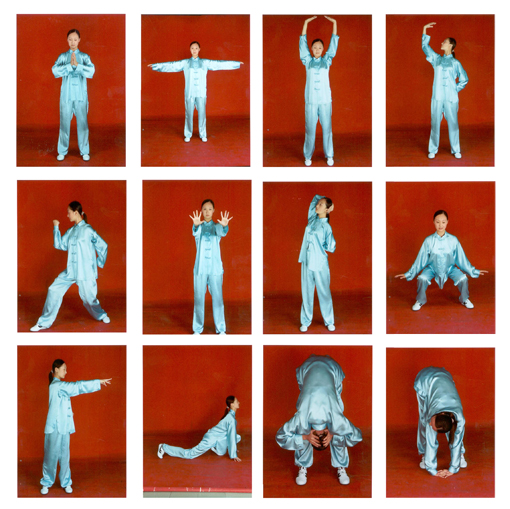
Dredging Channels, Regulating Qi Activity
Besides providing the “connecting” functions, channels can also facilitate the circulation of Qi and blood, just Huang Di Nei Jing: Ling Shu: Ben Zang says: “Channels are used to circulate blood and Qi and invigorate Yin and Yang”. Yi Jin Jing dredges channels mainly through body and breath regulation.
As mentioned above, the body regulation of Yi Jin Jing is a quite distinguished one. By combining the static-force motion with the dynamic-force motion and the limb motion with the spinal motion, it fully, reasonably, and intensely exercises all parts of the human body. The movements not only exercise the muscles, bones, and joints, but also indirectly “massage” the channels and blood vessels which also belong to “Jin”. This “massage” is realized by the diastolic and systolic movements of muscles, the abduction and adduction of joints, the rotation and bending of the spinal column, the ascending, descending, opening, and closing movements of both hands, the various stances of both legs, and many other elements of body regulation. It renders the channels and blood vessels in an irregular “compression-relaxation” state which is favorable for maintaining the smoothness of channels and blood channels and promotes the “blood and Qi circulation” of the human body (Hou Han Shu: Hua Tuo Zhuan). It ensures the unblocked flowing of essence and Qi because “the essence will not circulate if the body remains stationary and Qi will be stagnant if essence fails to circulate” (Lv Shi Chun Qiu: Da Yu).
In traditional Chinese medicine, Qi activity refers to the movements of Qi, which mainly include ascending, descending, incoming, and outgoing movements. It is also believed in traditional Chinese medicine that the lung governs Qi, the kidney accommodates Qi, and the liver dredges Qi. The spleen and the stomach are sources of the generation and conversion of Qi and blood. And since Qi mainly runs along the channels, the normal functioning of Qi activity is related to the conditions of all the five Zang viscera and the channels. Yi Jin Jing not only strengthens the “form” which covers all the five viscera but also dredges the channels. These two aspects are the main mechanisms by which Yi Jin Jing coordinates Qi activity. In addition, the effect of two features in the breath regulation of this exercise on Qi activity is also two important to ignore. One of them is the short halt of respiration during static-force motion, which is especially conspicuous in the first three postures of “Wei Tuo Presenting the Pestle”. It is specifically embodied in the “short halt of movement” mentioned by the author in Posture 1. This “suspension” also exists in the second and third postures. Seasoned practicers can even feel similar “halt” in other routines. As the “three regulations” are coordinated with each other until they are finally united during exercise, “short halt of movement” implies “short halt of respiration”. The meaning of “halt” differs with the stages of respiration. If the halt takes place at the end of an exhalation, it will be equivalent to an extension of the exhalation which enhances the “outgoing” movement of Qi activity and facilities the exhalation of the old and the reduction of excessiveness. If the halt takes place at the end of an inhalation, it will be equivalent to an extension of the inhalation which enhances the “incoming” movement of Qi activity and facilities the inhalation of the new and the makeup for the insufficiency. The practicers may use these halts flexibly according to their respective physical conditions. The other is the “Hai” pronunciation respiration in “Three Plates Falling on the Floor”. The effect of this pronunciation respiration on the viscera has been explained earlier. Moreover, it can also regulate the ascending and descending movements of Qi activity. However, if we take a general look at the keys to the body regulation and breath regulation of the entire exercise, we will find that the effect is largely a “descending” one. This is because the “Hai” which is articulated at the moment of the “falling-on-the-floor” movement is definitely mean for balancing the ascending and descending movements. Since the ancient times, Yi Jin Jing has been focused on the “incoming” and “ascending” movements of Qi probably in order to achieve better “Jin-changing” effect. And insufficient attention has been drawn to the “outgoing” and especially the “descending” movements. Failure of the practicers (especially beginners) to master the proper movements will cause the problem of excessive ascending movement and insufficient descending movement of Qi. Along with the descending movements of the body, the exhaling pronunciation will facilitate the descent of Qi and play an active role in balancing the ascent and descent of Qi and coordinating the Qi activity.
To sum up, through reasonably-arranged movements and assisted by corresponding respiration, Health Qigong ● Yi Jin Jing can strengthen the body, balance Yin and Yang, promote Qi and blood circulation, and thus help the practicer to “preserve health”. Supplemented by certain spirit regulation approaches, it may provide even better health-preserving effect.
(By Huang Jian)

